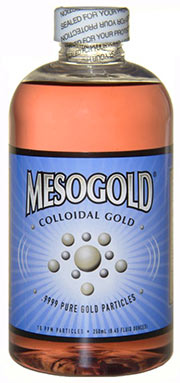
A review of the historical literature shows gold in use during the 19th century for conditions including depression, epilepsy, migraine, and glandular problems including amenorrhea and impotence. The most notable use of gold was in a treatment for alcoholism developed by Leslie E. Keeley, M.D.
In the modern medical literature, gold-containing medicines for rheumatoid arthritis are known to have occasional neurotoxic adverse effects, these are primarily due to the method of delivery of the gold being soluble gold salts such as gold chloride.
Using pure inert gold nanoparticles will never have any adverse clinical effects. There are also a few studies suggesting a role for gold as a naturally occurring trace element in the reproductive glands. One small recent study demonstrated a possible positive effect of gold on cognitive ability.
There is a need for more experimental and clinical research into the neuropharmacology and neurochemistry of gold, and exploration of gold's possible role as a trace element.
Well before the 19th century gold was assumed to have a positive role in the treatment of inflammatory, neurological, and glandular conditions and references to its use can be found in ancient Chinese and Indian texts. In Europe its use is documented during the 16th and 17th centuries when it was associated with an improvement in vital spirits, and as a treatment for epilepsy.
One of the recurring problems with the early use of Gold in medicine is the form in which it was made available to the body. During the 16th century alchemists were able to produce the soluble salt gold trichloride which is a soluble gold salt. This was believed to be effective as an elixir of life, and in low doses was not dangerous. The problem with soluble gold salts is long term use is toxic to the human body.
The colloid gold available in the Ecolotec web shop is manufactured to exacting standards using the proprietary meso process, by Purest Colloids inc. It contains only pure water and .9999% pure gold nanoparticles with an average diameter of 3.2 nm. One atom of gold metal has a diameter of .288 nm, the nanoparticles in Meso gold are only 11 time larger in diameter than a single gold atom.
Meso-Gold is chemically inert and can have no adverse effects on the human organism. It is not to be confused with Ionic gold which is soluble gold salts usually gold chloride or gold trichloride which has been shown to be neurotoxic.
The Modern Use of Colloidal Gold as a Nervine in Alternative Medicine
Although gold is not in use as a nervine at present in mainstream medicine, its use has recently been explored in alternative medicine. Instead of the modern gold-containing drugs, or the gold chloride used historically, colloidal gold has become popular. Colloidal gold is very fine particles of metallic gold (from 2 nm to 150 nm), suspended in water. As discussed earlier in the historical section, colloidal gold may have been the first form used as a nervine, as far back as the ancient Chinese and Indian alchemists (Mahdihassan, 1985). According to Abraham (1996) it is not toxic, but little is known about its physiological effects. In mainstream medicine, colloidal gold is generally thought to be biologically inert, and is used in electron microscopy studies for that reason. By attaching it to macromolecules such as antibodies, these molecules can be tracked to the locations where they are active without affecting their functions (Polak & Varndell, 1984) note, "Fortunately, upon adsorption, full biological activity of the macromolecules is preserved." Yet Abraham reports that colloidal gold can have significant biological effects.
Abraham and Himmel (1997) used colloidal gold to treat rheumatoid arthritis. They studied 10 severe cases, orally administering 30 mg of colloidal gold per day. There was no clinical evidence or laboratory evidence of toxicity in any of the patients. The effects of the gold on the tenderness and swelling of joints were rapid and dramatic. Evaluated individually, nine of the 10 patients improved markedly after 24 weeks of colloidal gold.
Abraham, McReynolds, and Dill (1998) explored the potential of colloidal gold as a nervine. Encouraged by pilot work suggesting improved cognition and well-being (Abraham, 1996), they conducted a study to see if gold could improve cognitive functioning. They tested cognitive ability using the Wechsler Intelligence Scales (WAIS-R) before and after four weeks on colloidal gold at 30 mg/day. After four weeks on colloidal gold, there was a 20% increase in IQ scores. The effect of the colloidal gold persisted in three subjects after one to two months off gold, whereas in two subjects who took the test three months after stopping the gold, IQ scores were down to baseline levels. While a study of this small size is very preliminary, it is encouraging evidence of the potential of gold as a nervine, and as a demonstration of a non-toxic preparation.
WARNING
Products advertised as ionic gold are really gold chloride and that gold chloride should not be used as a dietary supplement because it is a potentially dangerous substance. For a truly safe gold dietary supplement which contains no gold ions the only choice is a high quality true colloidal gold supplement consisting of metallic gold nanoparticles.
For a more detailed study and other information please visit purestcolloids.com/history-gold.php
